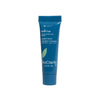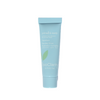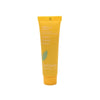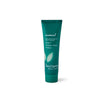Combat Dry Skin This Winter with Face Lotion
By Abby Vinas
Skin Types
•
0 Comments

Combat Dry Skin This Winter with Face Lotion
Has the colder weather brought uncomfortable dry, cracked, and irritated skin along with it? If it has, you’re not alone. In fact, most people—both men and women—experience drier skin during winter months. This can be super frustrating, especially for people who typically maintain an effortlessly dewy complexion.
While dry winter skin may be inevitable, it’s not incurable. First, let’s examine how the environment takes a toll on our skin so you can better understand how face lotion improves your cracking complexion.
How is Skin Structured?
Most people don’t have a thorough understanding of just how complex our skin is. The skin composes part of our body’s integumentary system—the system that protects the body from various kinds of damage, such as internal water loss or external abrasions. It’s only a few millimeters thick, but it’s our body’s largest organ, and our first line of defense. This makes our skin, the physical barrier constantly protecting our body, incredibly vulnerable and often underappreciated. Don’t forget to give it some TLC, and keep it healthy and strong using moisturizing lotion.
Your skin is composed of three layers:
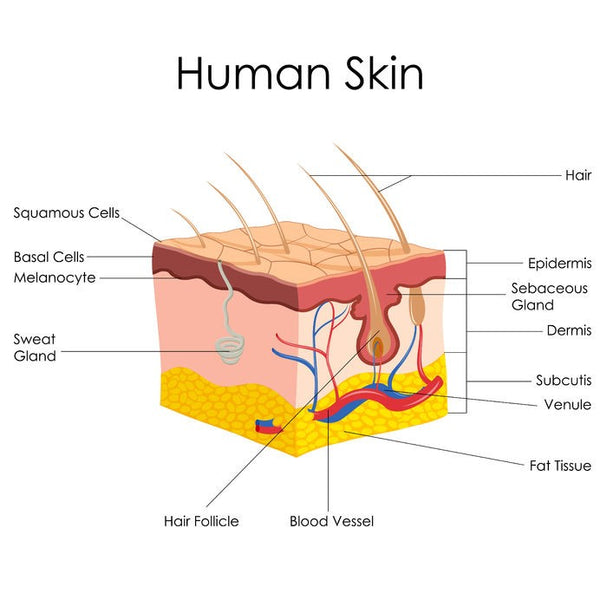
1. Epidermis: This is the outermost layer of skin, about as thick as a piece of paper and visible to the naked eye. It’s mainly made up of dead cells, called Keratinocytes, which are firmly stuck together to create an outer protective layer (stratum corneum). Your skin is ultimately composed of five sublayers altogether: Melanocytes produce and store a pigment called melanin, which helps protect us against harmful UV rays; Lymphocytes and Langerhans cells play an important role in fighting germs; finally, Merkel cells provide nerves that enable you to sense pressure. Your epidermis is constantly renewing itself. New cells are made in the lower layers where they then move to the surface within four weeks to harden and shed.
2. Dermis: Beneath the epidermis lies the dermis, the thickest layer of your skin, containing a dense network of collagen fibers which make the skin strong and elastic. It also contains small blood vessels, called capillaries, through which nutrients and oxygen in the blood pass into the skin cells. The nerve fibers within this layer contain the highest volume of sensory cells.
3. Hypodermis: The deepest layer of your skin contains mostly fat and connective tissue that stores water to maintain insulation and act as a shock absorber. Vitamin D in addition to other hormones are produced in these fat cells. Furthermore, the hypodermis contains blood vessels, nerves, sweat glands, and sebaceous (oil) glands.
The Science Behind Dry Skin
So what’s actually going on between these layers of your skin that’s causing it to feel dry, irritated, and flaky? Well, it’s the water content in the epidermis (or lack thereof) that makes the difference between normal and dry skin. Moisture is delivered to the skin via blood vessels to the dermis, which then travels upwards through the outer layer before evaporating. Remember those cells called Keratinocytes that cement together to form a protective shield over the living cells beneath them? Typically, this layer has the same surface area as the layers beneath it.
However, when the water evaporates from the stratum corneum, and the water content gets too low, the area will shrink in volume and surface area. As it continues to tighten against the skin below, it will eventually crack, causing that flaky or scaly appearance we recognize as dry skin. At this point, it becomes imperative to replenish dehydrating skin with face lotion to restore the skin’s moisture content.

What Causes Dry Skin?
Dry skin can be inherited, or caused by a number of factors. Our skin naturally produces oil (sebum) in an effort to seal in water that’s constantly evaporating. However, poor dieting, bathing in extreme heat, and using harsh soaps or detergents can deplete these factors. It’s easy to draw a correlation between a new product’s usage and spike in irritation. Simply toss the product and find gentler hydrating lotions. Unfortunately, we can’t control the weather, and most people are unaware that the environment can play a role in our skin’s quality outside of an average sunburn. If you receive damage from UV rays, it’s pretty easy to blame yourself for forgetting to apply face lotion before sun exposure. Seasonally dry skin is frustrating, however, because it’s not easy to tell what’s causing it. Let’s break down the science behind why so many people experience dry skin in the winter:
- During the winter, temperatures drop, and humidity rates fall.
- Due to cold weather, more central heating is used, which also drains humidity levels.
- The air density in times of low humidity makes it difficult for our skin to retain water.
- A process called transepidermal water loss occurs, in which moisture evaporates from the stratum corneum, o the outer layer of the epidermis.
- The stratum corneum needs moisture to be healthy, flexible, translucent, and firm.
- Without proper water content, the area will shrink, tighten, crack, and peel.
- Bitterly cold winds can also remove moisture and irritate exposed skin.
- Seeking relief from the chilly weather in the form of overly-hot showers will strip the skin of its natural oils, causing it to dehydrate and exacerbating the problem further.

Are All Skin Types Prone to Environmental Influence?
In short, yes. You might have naturally dry skin which worsens during the winter, but even if your skin tends to be oily, you can develop patches of dryness and irritation in colder weather.
In an ideal world, winter is said to be the best season for oily skin – no stickiness, no shine, and no need for oil-free lotion. Unfortunately, many oily-skin sufferers don’t get to experience a blissfully soft, glowing complexion in winter months.
The oily problem areas you once had might begin to appear normal, while the other portions of your face result in rough, dry patches, dull overtones, and sudden breakouts. Dermatologist refer to this type of skin as “combination T-zone,” and it can be difficult to try to treat the dry spots while keeping the excessive shine at bay.
If you find yourself in this position, be sure to moisturize with an oil-free lotion to avoid making your skincare woes even worse. If your sebaceous glands produce an excess amount of sebum, you should use lotion for oily skin to keep your skin moisturized during all seasons of the year.

How to Combat Dry Winter Skin
If you’re one among many whose skin is taking a beating this season, there are a few different strategies you can try to combat the symptoms of dry skin. To prevent dryness in the first place, the best thing you can do is to limit your exposure to the outdoors, but this isn’t always possible.
If you have somewhere you need to go that requires you to step out into the cold, be sure to bundle up, with scarves and beanies to shield from the harsh environment. When turning on your central heating is a must, be sure to turn on a humidifier alongside it, to prevent causing dry, stale air that sucks the moisture from your skin.
If you’ve already begun to notice an increased dryness or roughness of your skin’s texture, it’s time to go grab a healing facial lotion. Hydrating lotions work in one of two ways: the facial lotion either traps moisture in your skin to keep it from escaping, or it restores the moisture in the epidermis that’s already been lost. The underlying goal when applying moisturizing lotion is to boost the skin’s vitality and water content.
Recommended Product: bioClarity's Hydrate Skin Smoothie
External environmental factors – like blustering winds or cold temperatures – evaporate our skin’s moisture, strip it of its natural oils, leading to flaking and cracking. A good facial lotion will combat winter dryness by making the cells strong, supple, and withstanding, thereby preventing irritation and the onslaught of peeling or cracking.
Here are some tips to keep in mind when choosing and applying your moisturizing lotion:
- - Choose a facial lotion for your skin type. A light serum or milky lotion works well for oily skin, whereas excessive dry types would benefit more from thicker, heavier creams. If you have sensitive skin, avoid hydrating lotions containing fragrances and dyes.
- - Do a patch test whenever trying a new face lotion for the first time to avoid potential irritation or allergic reaction.
- - Apply a moisturizing lotion twice a day, especially during the dry winter months. The best time to apply is immediately after a warm – not hot! – shower or bath while your pores are still open and your skin slightly damp so it absorbs quickly.
- - When applying your moisturizing lotion, squeeze a pea-sized amount into your palm, warm it up in your hands, and then apply first to the cheeks, the forehead next, and finally the rest of the face. Remember not to forget your neck, and to use light, gentle upward strokes to lift the skin – never dragging it down.
Scientists have yet to discover any sacred, magical facial lotion or potion that can control the weather or roll back the clocks, but they’ve gotten pretty close. Major advances in biotechnology have led to dramatic improvements in hydrating lotions, and advanced ingredients in new formulas can truly work wonders to correct the dryness brought on by the cold.
If you’re trying to combat dry skin this winter, begin by implementing a face lotion into your beauty regimen as soon as possible.

Abby Vinas
Abby Vinas has long been an active member of the holistic health community, advocating in favor of its benefits to both our physical and emotional well-being. Her commitment to leading a healthy lifestyle has made her an authority on self-care practices. Abby is passionate about fitness, nutrition, and proper skincare, and is also an avid lover of avocado toast and dog-petting.
